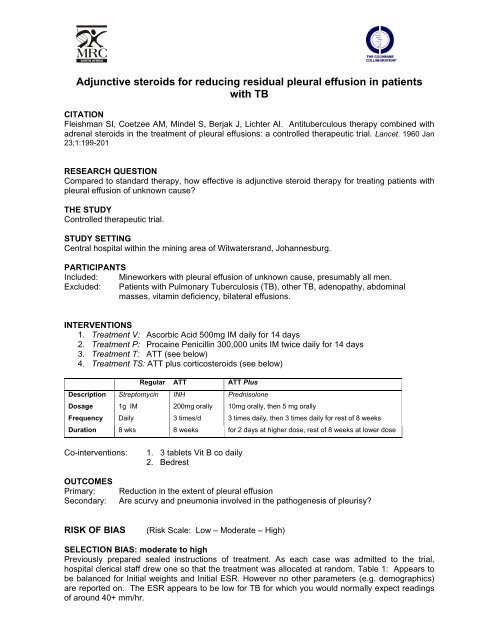Adjunctive steroids for reducing residual pleural effusion in patients ...
Adjunctive steroids for reducing residual pleural effusion in patients ...
Adjunctive steroids for reducing residual pleural effusion in patients ...
Create successful ePaper yourself
Turn your PDF publications into a flip-book with our unique Google optimized e-Paper software.
<strong>Adjunctive</strong> <strong>steroids</strong> <strong>for</strong> <strong>reduc<strong>in</strong>g</strong> <strong>residual</strong> <strong>pleural</strong> <strong>effusion</strong> <strong>in</strong> <strong>patients</strong><br />
with TB<br />
CITATION<br />
Fleishman SI, Coetzee AM, M<strong>in</strong>del S, Berjak J, Lichter AI. Antituberculous therapy comb<strong>in</strong>ed with<br />
adrenal <strong>steroids</strong> <strong>in</strong> the treatment of <strong>pleural</strong> <strong>effusion</strong>s: a controlled therapeutic trial. Lancet. 1960 Jan<br />
23;1:199-201<br />
RESEARCH QUESTION<br />
Compared to standard therapy, how effective is adjunctive steroid therapy <strong>for</strong> treat<strong>in</strong>g <strong>patients</strong> with<br />
<strong>pleural</strong> <strong>effusion</strong> of unknown cause?<br />
THE STUDY<br />
Controlled therapeutic trial.<br />
STUDY SETTING<br />
Central hospital with<strong>in</strong> the m<strong>in</strong><strong>in</strong>g area of Witwatersrand, Johannesburg.<br />
PARTICIPANTS<br />
Included: M<strong>in</strong>eworkers with <strong>pleural</strong> <strong>effusion</strong> of unknown cause, presumably all men.<br />
Excluded: Patients with Pulmonary Tuberculosis (TB), other TB, adenopathy, abdom<strong>in</strong>al<br />
masses, vitam<strong>in</strong> deficiency, bilateral <strong>effusion</strong>s.<br />
INTERVENTIONS<br />
1. Treatment V: Ascorbic Acid 500mg IM daily <strong>for</strong> 14 days<br />
2. Treatment P: Proca<strong>in</strong>e Penicill<strong>in</strong> 300,000 units IM twice daily <strong>for</strong> 14 days<br />
3. Treatment T: ATT (see below)<br />
4. Treatment TS: ATT plus cortico<strong>steroids</strong> (see below)<br />
Regular ATT ATT Plus<br />
Description Streptomyc<strong>in</strong> INH Prednisolone<br />
Dosage 1g IM 200mg orally 10mg orally, then 5 mg orally<br />
Frequency Daily 3 times/d 3 times daily, then 3 times daily <strong>for</strong> rest of 8 weeks<br />
Duration 8 wks 8 weeks <strong>for</strong> 2 days at higher dose, rest of 8 weeks at lower dose<br />
Co-<strong>in</strong>terventions: 1. 3 tablets Vit B co daily<br />
2. Bedrest<br />
OUTCOMES<br />
Primary: Reduction <strong>in</strong> the extent of <strong>pleural</strong> <strong>effusion</strong><br />
Secondary: Are scurvy and pneumonia <strong>in</strong>volved <strong>in</strong> the pathogenesis of pleurisy?<br />
RISK OF BIAS (Risk Scale: Low – Moderate – High)<br />
SELECTION BIAS: moderate to high<br />
Previously prepared sealed <strong>in</strong>structions of treatment. As each case was admitted to the trial,<br />
hospital clerical staff drew one so that the treatment was allocated at random. Table 1: Appears to<br />
be balanced <strong>for</strong> Initial weights and Initial ESR. However no other parameters (e.g. demographics)<br />
are reported on. The ESR appears to be low <strong>for</strong> TB <strong>for</strong> which you would normally expect read<strong>in</strong>gs<br />
of around 40+ mm/hr.
PERFORMANCE BIAS: low<br />
(ie: What else happened that may have affected the result?)<br />
Patients not bl<strong>in</strong>ded - Not a problem s<strong>in</strong>ce outcome is not affected by patient’s per<strong>for</strong>mance.<br />
Patients were conf<strong>in</strong>ed to hospital – good compliance to therapy<br />
Period of bed rest varied accord<strong>in</strong>g to “patient’s condition” – article did not clarify who made this<br />
judgement.<br />
Initial aspiration of 20 ml of <strong>pleural</strong> fluid may affect first four weeks’ score.<br />
DETECTION BIAS: low<br />
Pleural <strong>effusion</strong>s were scored by a panel of 5 doctors who, accord<strong>in</strong>g to the authors, were bl<strong>in</strong>ded<br />
to the patient's treatment. No <strong>in</strong>dication that the laboratory staff was bl<strong>in</strong>ded.<br />
However, it appears as if the panel were aware of the treatment given at the beg<strong>in</strong>n<strong>in</strong>g of the trial<br />
s<strong>in</strong>ce on page 200, column 2 – "this result became known only at the completion of his course of<br />
treatment" almost <strong>in</strong>dicat<strong>in</strong>g that they would have changed the treatment had they known?<br />
ATTRITION BIAS:<br />
No <strong>in</strong>tention to treat analysis per<strong>for</strong>med.<br />
P V ATT ATT + S Total<br />
Started 19 21 19 20 79<br />
Completed 17 19 19 20 75<br />
Assessed 16 18 19 20 73<br />
STUDY FINDINGS<br />
Significant reduction <strong>in</strong> the extent of the <strong>effusion</strong> <strong>in</strong> TS at 4 weeks<br />
No significant reduction seen from 4 weeks to 8 weeks<br />
PRESENCE OF RESIDUAL FLUID (95% CI)<br />
Treatment Event Rate RRR ARR NNT<br />
4 weeks TS E 11/20 = 0.55 35% 0.29 4<br />
T C 16/19 = 0.84 (2%; 67%) (0.02; 0.57) (2 – 52)<br />
8 weeks TS E 8/20 = 0.40 49% 0.39 3<br />
T C 15/19 = 0.79 (14%; 85%) (0.11; 0.67) (1 – 9)<br />
ADVERSE EVENTS<br />
Four <strong>patients</strong> deteriorated: Treatment change from V, P to T, TS<br />
COMMENTS<br />
<strong>Adjunctive</strong> steroid therapy appears to be an effective treatment <strong>for</strong> <strong>reduc<strong>in</strong>g</strong> <strong>residual</strong> <strong>pleural</strong> fluid <strong>in</strong><br />
<strong>patients</strong> with <strong>pleural</strong> <strong>effusion</strong> of unknown cause.<br />
Prepared by: MARK ENGEL<br />
E-mail: mark.engel@mrc.ac.za<br />
Date: 15 June 2004












